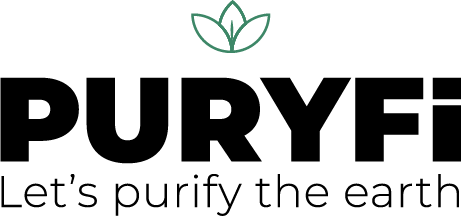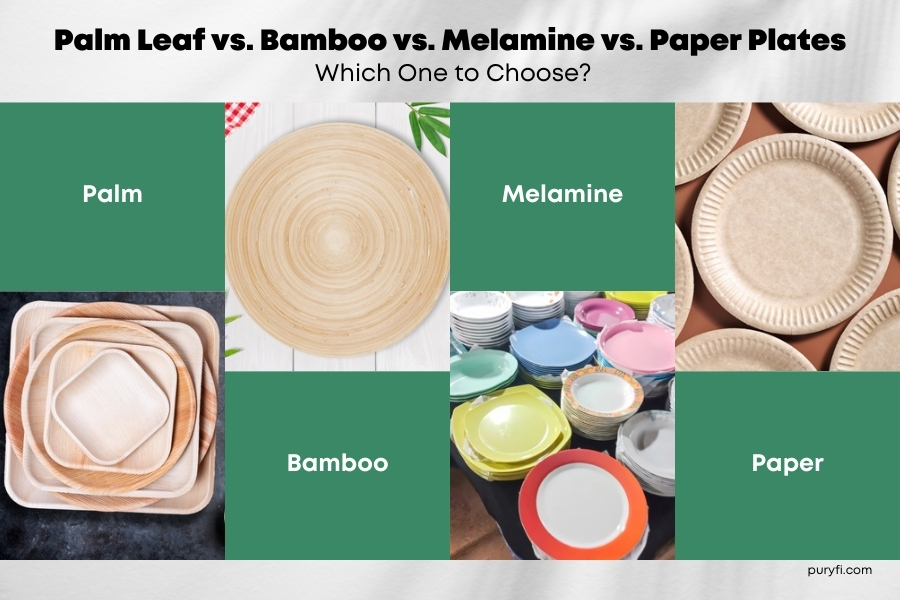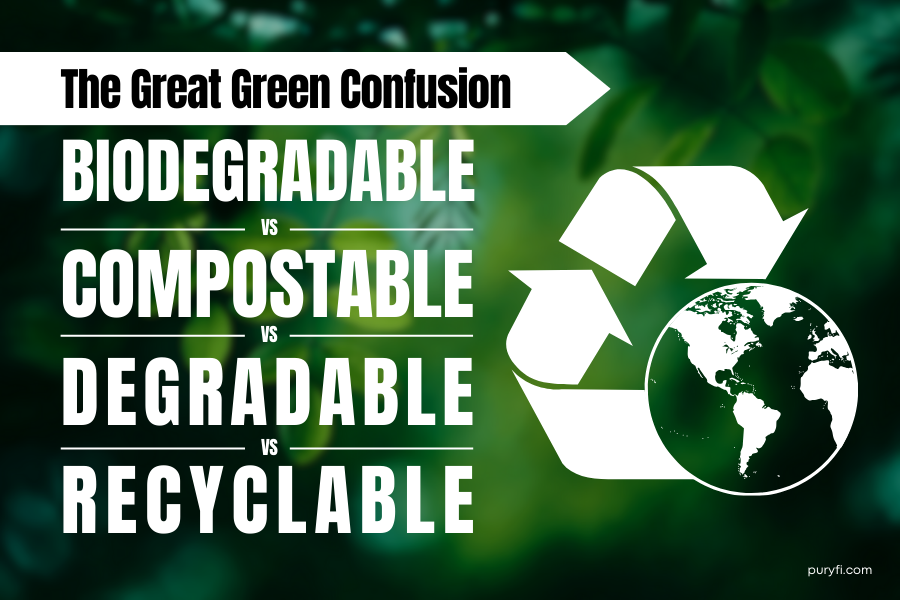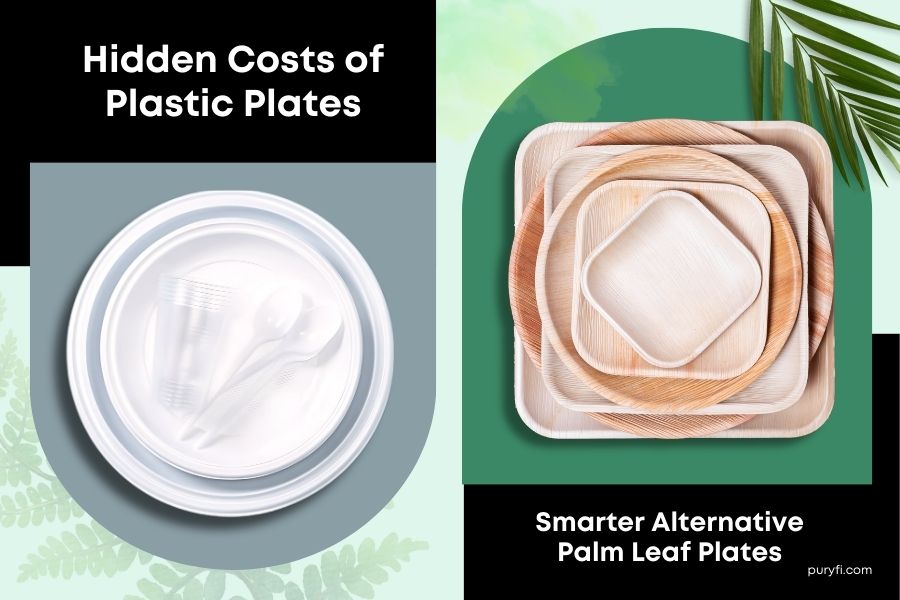
Have you ever grabbed a stack of plastic plates for a party, thinking they were the easiest and cheapest option? It’s a no-brainer. But what if those “cheap” plates were costing you—and the environment—more than you realized? From hidden health risks to long-term environmental damage, plastic tableware is priced beyond the checkout counter.
Keep reading to uncover the real cost of using plastic tableware and why palm leaf plates are the smarter choice.
The True Cost of Plastic Plates
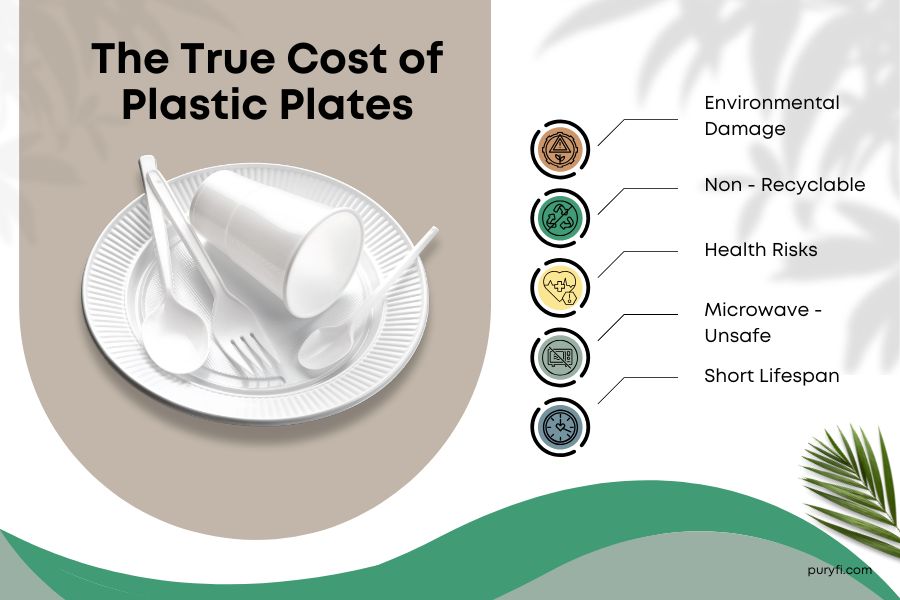
At first glance, the cost of plastic plates is minimal. However, the disadvantages of plastic plates extend far beyond their purchase price. Here’s why they are not as economical as they seem:
1. Environmental Damage and Cleanup Costs
One of the biggest hidden costs of plastic is its contribution to environmental pollution. Single-use plastic plates are neither biodegradable nor compostable, which means they end up in landfills or, worse, in oceans and waterways. Governments and taxpayers bear the financial burden of waste management, beach cleanups, and pollution mitigation.
2. Are Plastic Plates Recyclable?
While some plastic plates are technically recyclable, the reality is that most of them are not. Many plastic products are made from polystyrene (Styrofoam) or other non-recyclable plastics. Even when they are recyclable, food residue often makes them unsuitable for processing. Contaminated plates can clog machinery, lower the quality of recycled material, and even cause entire batches to be discarded. Additionally, certain plastics, like polystyrene, are difficult and costly to recycle due to their lightweight structure and low market value. As a result, most plastic end up in landfills or incinerators rather than being repurposed.
This means they contribute to the growing problem of plastic waste, requiring expensive disposal solutions.
3. Health Risks and Medical Costs
Are plastic plates bad for you? The answer is complicated. Many plastic plates contain harmful chemicals like BPA and phthalates, which can leach into food, especially when exposed to heat. The long-term health costs associated with plastic use are rarely considered when making purchasing decisions, but they can be substantial.
4. Are Plastic Plates Microwave Safe?
Can you put plastic plates in the microwave? The short answer: it depends. Some plastic containers claim to be microwave-safe, but repeated heating can break down plastic, increasing the likelihood of chemical leaching. If you’ve ever wondered, “Are plastic plates safe?” the reality is that many of them pose potential risks, particularly when heated. This makes them a poor choice for reheating food, leading consumers to spend more on safer alternatives.
5. Short Lifespan and Repeat Purchases
Unlike durable alternatives, plastic tableware is designed for single-use or limited reuse. This means consumers must repeatedly purchase them, adding up over time. In contrast, biodegradable options like palm leaf plates are sturdier and don’t require constant repurchasing, making them a more cost-effective choice.
How Palm Leaf Plates Save You Money
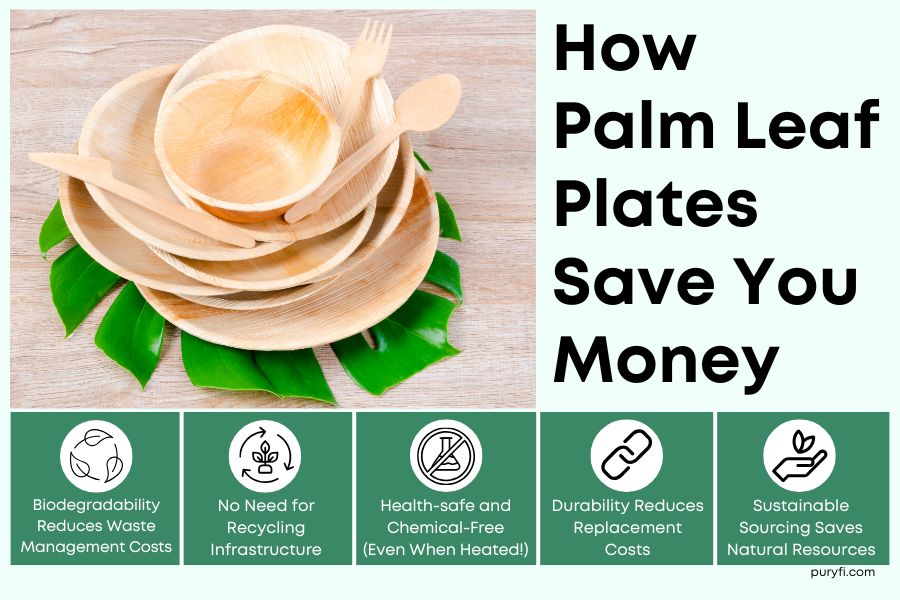
Switching from plastic to palm leaf plates offers numerous benefits, both financially and environmentally. Here’s why they are the smarter investment:
1. Biodegradability Reduces Waste Management Costs
Unlike plastic plates that sit in landfills for centuries, palm leaf plates are completely biodegradable and compostable. This reduces the burden on waste management systems and eliminates the hidden cost of long-term environmental damage.
2. No Need for Recycling Infrastructure
Palm leaf plates don’t require specialized recycling facilities. They break down naturally, even in your backyard compost, making disposal easy and eco-friendly. This helps municipalities and businesses save money on waste processing costs while allowing consumers to dispose of them effortlessly without worrying about proper recycling methods.
To know more about backyard composting, read our blog: How to Make Compost at Home: A Step-by-Step Guide to Sustainable Living
3. Health-safe and Chemical-Free (Even When Heated!)
Palm leaf plates contain no artificial chemicals, ensuring they are safe for both hot and cold foods. Unlike plastic plates, they do not leach harmful substances when heated. Are palm leaf plates microwave-safe? Yes! Unlike plastic, palm leaf plates can safely withstand heat without releasing toxins, making them a much safer option for food reheating.
4. Durability Reduces Replacement Costs
Palm leaf plates are far more durable than plastic alternatives. They hold up well to hot and heavy foods without bending or leaking, reducing the need for double stacking or using multiple plates per meal. This means fewer plates are needed per event, leading to cost savings over time.
5. Sustainable Sourcing Saves Natural Resources
Palm leaf plates are made from naturally shed leaves, making them an eco-friendly and sustainable choice. Unlike plastic production, which relies on fossil fuels and contributes to greenhouse gas emissions, palm leaf plates have a minimal environmental footprint. This sustainability reduces long-term environmental costs that often translate into higher taxes and expenses for consumers.
The Bigger Picture: Long-Term Savings and Sustainability
When comparing the cost of plastic plates to palm leaf alternatives, it’s essential to look beyond the price tag. Plastic has financial and environmental consequences that make it a far more expensive choice in the long run. Palm leaf tableware, while slightly higher in upfront cost, offers durability, safety, and sustainability—leading to significant savings over time.
Governments, businesses, and consumers alike are shifting toward sustainable alternatives. Many regions are even banning single-use plastics, making the switch to biodegradable options inevitable. Choosing palm leaf plates now can help you stay ahead of regulations while contributing to a healthier planet.
Final Thoughts
The disadvantages of plastic plates go far beyond their initial price. One of the biggest concerns remains: Are plastic plates microwave-safe? While some are labeled safe, the risks of chemical leaching make them a questionable option for regular use.
On the other hand, palm leaf plates provide a sustainable, durable, and cost-effective alternative. They are microwave-safe, free from harmful chemicals, and better for the environment. By making the switch, you save money and contribute to a cleaner, healthier world. Next time you reach for plastic, consider the bigger picture. Investing in palm leaf plates is a smart financial and environmental decision that benefits everyone in the long run.
